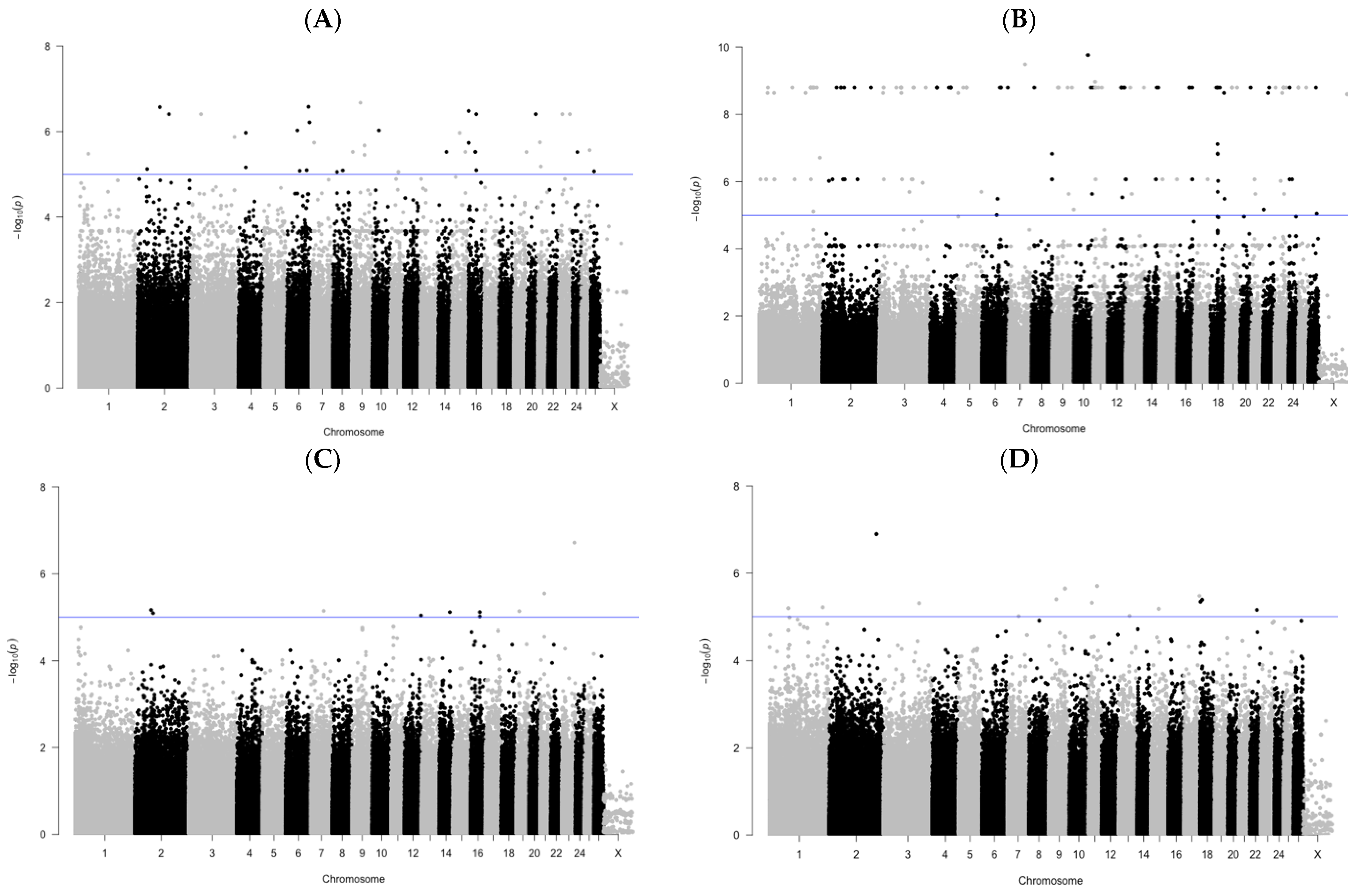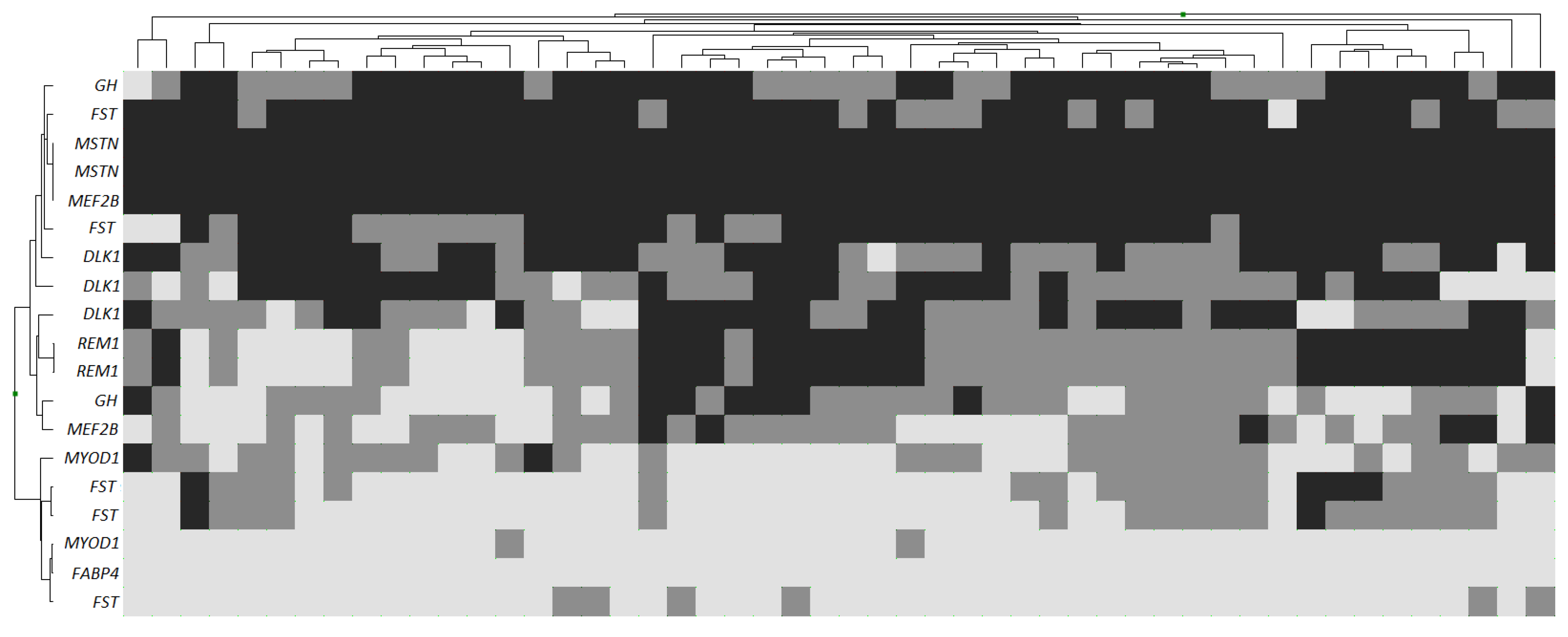Genome-Wide Search for Associations with Meat Production Parameters in Karachaevsky Sheep Breed Using the Illumina BeadChip 600 K
Abstract
1. Introduction
2. Materials and Methods
2.1. Ethics Statement
2.2. Animals Used and Obtaining Samples
2.3. Extraction of DNA and Genotyping
2.4. Quality Control of Genotyping
2.5. Genetic and Statistical Analysis
3. Results
4. Discussion
5. Conclusions
Author Contributions
Funding
Institutional Review Board Statement
Informed Consent Statement
Data Availability Statement
Conflicts of Interest
References
- Abousoliman, I.; Reyer, H.; Oster, M.; Muráni, E.; Mourad, M.; Rashed, M.; Abdel-Salam, M.I.; Wimmers, K. Analysis of candidate genes for growth and milk performance traits in the Egyptian Barki sheep. Animals 2020, 10, 197. [Google Scholar] [CrossRef] [PubMed]
- Masari, H.A.P.; Hafezian, S.H.; Mokhtari, M.; Mianji, G.R.; Abdollahi-Arpanahi, R. Inferring causal relationships among growth curve traits of Lori-Bakhtiari sheep using structural equation models. Small Rumin. Res. 2021, 203, 106489. [Google Scholar] [CrossRef]
- Mohammadreza, M.; Bordbar, F.; Jensen, J.; Du, M.; Guo, W. Key Genes Regulating Skeletal Muscle Development and Growth in Farm Animals. Animals 2021, 11, 835. [Google Scholar] [CrossRef]
- Marina, H.; Reverter, A.; Gutiérrez-Gil, B.; Alexandre, P.A.; Porto-Neto, L.R.; Suárez-Vega, A. Gene networks driving genetic variation in milk and cheese-making traits of Spanish Assaf sheep. Genes 2020, 11, 715. [Google Scholar] [CrossRef]
- Tellam, R.L.; Cockett, N.E.; Vuocolo, T.; Bidwell, C.A. Genes contributing to genetic variation of muscling in sheep. Front. Genet. 2012, 3, 164. [Google Scholar] [CrossRef] [PubMed]
- Ahad, W.A.; Andrabi, M.; Beigh, S.A.; Bhat, R.A.; Shah, R.A. Applications of myostatin (MSTN) gene in the livestock animals and humans: A review. Int. J. Curr. Microbiol. Appl. Sci. 2017, 6, 1807–1811. [Google Scholar]
- Georges, M.; Charlier, C.; Cockett, N. The callipyge locus: Evidence for the trans interaction of reciprocally imprinted genes. Trends Genet. 2003, 19, 248–252. [Google Scholar] [CrossRef]
- Spiller, M.P.; Kambadur, R.; Jeanplong, F.; Thomas, M.; Martyn, J.K.; Bass, J.J.; Sharma, M. The myostatin gene is a downstream target gene of basic helix-loop-helix transcription factor MyoD. Mol. Cell. Biol. 2002, 22, 7066–7082. [Google Scholar] [CrossRef]
- Aiello, D.; Patel, K.; Lasagna, E. The myostatin gene: An overview of mechanisms of action and its relevance to livestock animals. Anim. Genet. 2018, 49, 505–519. [Google Scholar] [CrossRef]
- Nissinen, T.A.; Hentilä, J.; Fachada, V.; Lautaoja, J.H.; Pasternack, A.; Ritvos, O.; Kivelä, R.; Hulmi, J.J. Muscle follistatin gene delivery increases muscle protein synthesis independent of periodical physical inactivity and fasting. FASEB J. 2021, 35, e21387. [Google Scholar] [CrossRef]
- Bolormaa, S.; Hayes, B.J.; van der Werf, J.H.J.; Pethick, D.; Goddard, M.E.; Daetwyler, H.D. Detailed phenotyping identifies genes with pleiotropic effects on body composition. BMC Genom. 2016, 7, 224. [Google Scholar] [CrossRef]
- Knapik, J.; Ropka-Molik, K.; Pieszka, M. Genetic and nutritional factors determining the production and quality of sheep meat–a review. Ann. Anim. Sci. 2017, 17, 23–40. [Google Scholar] [CrossRef]
- Gebreselassie, G.; Berihulay, H.; Jiang, L.; Ma, Y. Review on genomic regions and candidate genes associated with economically important production and reproduction traits in sheep (Ovies aries). Animals 2019, 10, 33. [Google Scholar] [CrossRef]
- Gavran, M.; Antunović, Z.; Gantner, V. Candidate Genes Associated with Economically Important Traits of Sheep-A Review. Agric. Conspec. Sci. 2021, 86, 195–201. [Google Scholar]
- Rauw, W.M.; Gomez-Raya, L. Genotype by environment interaction and breeding for robustness in livestock. Front. Genet. 2015, 6, 310. [Google Scholar] [CrossRef]
- Tambiev, H.M. History and Way of Development of Karachaevsky Sheep Breed; Karachaevsk SRI Publishing: Cherkessk, Russia, 2007; p. 221. (In Russian) [Google Scholar]
- Bolatchiev, A.T.; Ibragimov, Y.N.; Kubanov, A.M. Karachaevsky sheep breed and direction of improve of productivity. Zootekhnia 2012, 4, 18–19. [Google Scholar]
- Zhang, L.; Liu, J.; Zhao, F.; Ren, H.; Xu, L.; Lu, J.; Zhang, S.; Zhang, X.; Wei, C.; Lu, G.; et al. Genome-wide association studies for growth and meat production traits in sheep. PLoS ONE 2013, 8, e66569. [Google Scholar] [CrossRef] [PubMed]
- Brito, L.F.; Clarke, S.M.; McEwan, J.C.; Miller, S.P.; Pickering, N.K.; Bain, W.E.; Dodds, K.G.; Sargolzaei, M.; Schenkel, F.S. Prediction of genomic breeding values for growth, carcass and meat quality traits in a multi-breed sheep population using a HD SNP chip. BMC Genet. 2017, 18, 1–17. [Google Scholar] [CrossRef] [PubMed]
- Purcell, S.; Neale, B.; Todd-Brown, K. PLINK: A tool set for whole-genome association and population-based linkage analyses. Am. J. Hum. Genet. 2007, 81, 559–575. [Google Scholar] [CrossRef]
- Katoh, Y.; Ritter, B.; Gaffry, T.; Blondeau, F.; Höning, S.; McPherson, P.S. The clavesin family, neuron-specific lipid- and clathrin-binding Sec14 proteins regulating lysosomal morphology. J. Biol. Chem. 2009, 284, 27646–27654. [Google Scholar] [CrossRef] [PubMed]
- Lane, B.M.; Chryst-Stangl, M.; Wu, G.; Shalaby, M.; El Desoky, S.; Middleton, C.C.; Huggins, K.; Sood, A.; Ochoa, A.; Malone, A.F.; et al. Steroid-sensitive nephrotic syndrome candidate gene CLVS1 regulates podocyte oxidative stress and endocytosis. JCI Insight 2022, 7, e152102. [Google Scholar] [CrossRef]
- D’Asdia, M.C.; Torrente, I.; Consoli, F.; Ferese, R.; Magliozzi, M.; Bernardini, L.; Guida, V.; Digilio, M.C.; Marino, B.; Dallapiccola, B.; et al. Novel and recurrent EVC and EVC2 mutations in Ellis-van Creveld syndrome and Weyers acrofacial dyostosis. Eur. J. Med. Genet. 2013, 56, 80–87. [Google Scholar] [CrossRef]
- Schou, K.; Mogensen, J.; Morthorst, S. KIF13B establishes a CAV1-enriched microdomain at the ciliary transition zone to promote Sonic hedgehog signalling. Nat. Commun. 2017, 8, 14177. [Google Scholar] [CrossRef] [PubMed]
- Maris, C.; Dominguez, C.; Allain, F.H. The RNA recognition motif, a plastic RNA-binding platform to regulate post-transcriptional gene expression. FEBS J. 2005, 272, 2118–2131. [Google Scholar] [CrossRef]
- Zhang, M.; Shan, Y.; Pei, D. Mechanism underlying delayed rectifying in human voltage-mediated activation Eag2 channel. Nat. Commun. 2023, 14, 1470. [Google Scholar] [CrossRef] [PubMed]
- Chen, C.; Matesic, L.E. The Nedd4-like family of E3 ubiquitin ligases and cancer. Cancer Metastasis Rev. 2007, 26, 587–604. [Google Scholar] [CrossRef]
- Stepanov, V.; Vagaitseva, K.; Bocharova, A. Analysis of association of genetic markers in the LUZP2 and FBXO40 genes with the normal variability in cognitive performance in the elderly. Int. J. Alzheimer’s Dis. 2018, 2018, 2686045. [Google Scholar] [CrossRef] [PubMed]
- Damek-Poprawa, M.; Diemer, T.; Lopes, V.S.; Lillo, C.; Harper, D.C.; Marks, M.S.; Wu, Y.; Sparrow, J.R.; Rachel, R.A.; Williams, D.S.; et al. Melanoregulin (MREG) modulates lysosome function in pigment epithelial cells. J. Biol. Chem. 2009, 284, 10877–10889. [Google Scholar] [CrossRef]
- Shan, K.S.; Zhang, X.P.; Wang, J.S.; Guo, X.B.; Shang, L.; Tian, F.; Jing, C.Q.; Li, L.P.; Wan, D.S.; Li, C.S. Usefulness of large-section cytokeratin 20 in the detection of intestinal wall infiltration and mesangial metastasis in patients with middle and lower rectal cancer. J. Cancer Res. Ther. 2019, 15, 437–441. [Google Scholar] [CrossRef]
- Saygı, C.; Alanay, Y.; Sezerman, U.; Yenenler, A.; Özören, N. A possible founder mutation in FZD6 gene in a Turkish family with autosomal recessive nail dysplasia. BMC Med. Genet. 2019, 20, 15. [Google Scholar] [CrossRef] [PubMed]
- Zhang, J.; Wang, J.L.; Zhang, C.Y.; Ma, Y.F.; Zhao, R.; Wang, Y.Y. The prognostic role of FZD6 in esophageal squamous cell carcinoma patients. Clin. Transl. Oncol. 2020, 22, 1172–1179. [Google Scholar] [CrossRef] [PubMed]
- Krivoruchko, A.; Surov, A.; Skokova, A.; Kanibolotskaya, A.; Saprikina, T.; Kukharuk, M.; Yatsyk, O. A Genome-Wide Search for Candidate Genes of Meat Production in Jalgin Merino Considering Known Productivity Genes. Genes 2022, 13, 1337. [Google Scholar] [CrossRef] [PubMed]


| Trait | Chr | SNP | Position | p-Value | Alleles | Gene/Distance, bp |
|---|---|---|---|---|---|---|
| HC | 9 | rs422045180 | 39,532,603 | 2.124 × 10−7 | T/C | CLVS1/124 459 |
| 6 | rs417736092 | 103,289,306 | 2.648 × 10−7 | C/T | EVC2/exon 24 | |
| 2 | rs413063685 | 102,482,150 | 2.694 × 10−7 | T/C | KIF13B/intron 19–20 | |
| WC | 10 | rs404643411 | 61,939,091 | 1.734 × 10−10 | A/C | ENSOART00000000511.1/259 847 |
| 7 | rs412409461 | 71,628,646 | 3.286 × 10−10 | C/T | KCNH5/244 808 | |
| WB | 23 | rs430586829 | 57,324,967 | 1.921 × 10−7 | G/A | NEDD4/88 688 |
| 21 | rs411231795 | 19,797,164 | 2.875 × 10−6 | T/C | LUZP2/54 924 | |
| DAT | 2 | rs420787493 | 216,958,135 | 1.256 × 10−7 | T/G | MREG/intron 2–3 |
| 11 | rs404092476 | 40,665,455 | 1.961 × 10−6 | C/A/T | KRT20/18 705; KRT23/25 186 | |
| 9 | rs400604822 | 73,908,694 | 2.238 × 10−6 | C/T | FZD6/intron 1–2 | |
| 9 | rs425102210 | 73,915,521 | 2.238 × 10−6 | G/T | FZD6/intron 1–2 | |
| 9 | rs419561696 | 73,922,648 | 2.238 × 10−6 | T/C | FZD6/intron 1–2 |
| Gene | SNP | Chr | Position | LW, p-Value | DME, p-Value |
|---|---|---|---|---|---|
| MSTN | oar3_OAR2_118149265 | 2 | 118,149,265 | N/A | N/A |
| MSTN | oar3_OAR2_118150665 | 2 | 118,150,665 | N/A | N/A |
| MEF2B | oar3_OAR5_3860373 | 5 | 3,860,373 | 0.459 | 0.305 |
| MEF2B | oar3_OAR5_3867887 | 5 | 3,867,887 | N/A | N/A |
| FABP4 | oar3_OAR9_57537070 | 9 | 57,537,070 | N/A | N/A |
| GH | oar3_OAR11_47529756 | 11 | 47,529,756 | 0.476 | 0.726 |
| GH | oar3_OAR11_47545769 | 11 | 47,545,769 | 0.305 | 0.514 |
| REM1 | oar3_OAR13_60384593 | 13 | 60,384,593 | 0.398 | 0.642 |
| REM1 | oar3_OAR13_60385591 | 13 | 60,385,591 | 0.573 | 0.460 |
| MYOD1 | oar3_OAR15_3434222 | 15 | 3,434,222 | 0.741 | 0.758 |
| MYOD1 | oar3_OAR15_3441596 | 15 | 3,441,596 | 0.436 | 0.233 |
| FST | OAR16_27849538.1 | 16 | 25,631,318 | 0.383 | 0.416 |
| FST | oar3_OAR16_25632659 | 16 | 25,632,659 | 0.457 | 0.585 |
| FST | oar3_OAR16_25632701 | 16 | 25,632,701 | 0.614 | 0.743 |
| FST | oar3_OAR16_25633632 | 16 | 25,633,632 | 0.492 | 0.178 |
| FST | oar3_OAR16_25638968 | 16 | 25,638,968 | 0.430 | 0.272 |
| DLK1 | oar3_OAR18_64313560 | 18 | 64,313,560 | 0.718 | 0.628 |
| DLK1 | oar3_OAR18_64314938 | 18 | 64,314,938 | 0.656 | 0.270 |
| DLK1 | oar3_OAR18_64341672 | 18 | 64,341,672 | 0.742 | 0.519 |
Disclaimer/Publisher’s Note: The statements, opinions and data contained in all publications are solely those of the individual author(s) and contributor(s) and not of MDPI and/or the editor(s). MDPI and/or the editor(s) disclaim responsibility for any injury to people or property resulting from any ideas, methods, instructions or products referred to in the content. |
© 2023 by the authors. Licensee MDPI, Basel, Switzerland. This article is an open access article distributed under the terms and conditions of the Creative Commons Attribution (CC BY) license (https://creativecommons.org/licenses/by/4.0/).
Share and Cite
Krivoruchko, A.; Likhovid, A.; Kanibolotskaya, A.; Saprikina, T.; Safaryan, E.; Yatsyk, O. Genome-Wide Search for Associations with Meat Production Parameters in Karachaevsky Sheep Breed Using the Illumina BeadChip 600 K. Genes 2023, 14, 1288. https://doi.org/10.3390/genes14061288
Krivoruchko A, Likhovid A, Kanibolotskaya A, Saprikina T, Safaryan E, Yatsyk O. Genome-Wide Search for Associations with Meat Production Parameters in Karachaevsky Sheep Breed Using the Illumina BeadChip 600 K. Genes. 2023; 14(6):1288. https://doi.org/10.3390/genes14061288
Chicago/Turabian StyleKrivoruchko, Alexander, Andrey Likhovid, Anastasiya Kanibolotskaya, Tatiana Saprikina, Elena Safaryan, and Olesya Yatsyk. 2023. "Genome-Wide Search for Associations with Meat Production Parameters in Karachaevsky Sheep Breed Using the Illumina BeadChip 600 K" Genes 14, no. 6: 1288. https://doi.org/10.3390/genes14061288
APA StyleKrivoruchko, A., Likhovid, A., Kanibolotskaya, A., Saprikina, T., Safaryan, E., & Yatsyk, O. (2023). Genome-Wide Search for Associations with Meat Production Parameters in Karachaevsky Sheep Breed Using the Illumina BeadChip 600 K. Genes, 14(6), 1288. https://doi.org/10.3390/genes14061288





